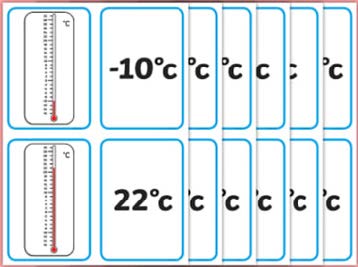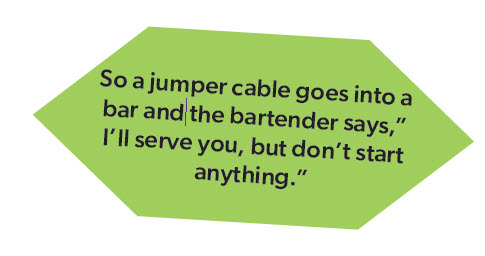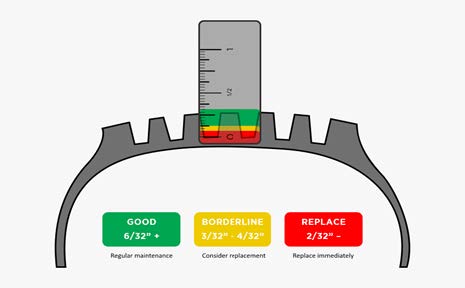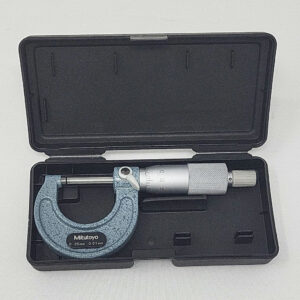38 Activities

Thermometer Game Idea

- Create cards of different measurement markings shown on a thermometer.
- Create anther deck of cards with just the written temperatures on them.
- Mix and match the cards with your friends to practice reading thermometers!


Tread Depth
What do tread depth numbers mean?
The tire tread depth gauge measures in 32nds of an inch. A good tire tread depth is [latex]\tfrac{6}{32}[/latex] or deeper. If the depth is [latex]\tfrac{4}{32}[/latex], its time to consider replacing your tires for new ones. [latex]\tfrac{2}{32}[/latex] or less means that you should change your tires ASAP. A legal winter tire must have [latex]\tfrac{3}{32}[/latex] of tread depth. Regular tread depth checks help avoid sliding and skidding on the roads while braking.
Checking your tire tread depth:
- Park and turn off your car. Ensure the emergency brake is on.
- Grab the depth gauge, find the pin, and insert it into the grooves between the treads of the tire. Press down on the base plate of the gauge unit until it’s flush with the tire tread.
- Repeat step 2 in at least 4 different places on each tire for an accurate read.
- The lowest reading you get is going to be the correct overall reading for the tire. If the reading fluctuates across multiple points on the same tire, your tires need to be replaced.
- Find out what those readings mean:
Tread Depth What to do Impact to Braking Distance [latex]\tfrac{5}{32}[/latex]″ or more Nothing Minimal [latex]\tfrac{3}{32}[/latex]″ to [latex]\tfrac{4}{32}[/latex]″ Consider replacing Significant [latex]\tfrac{2}{32}[/latex]″ or less Replace immediately Very significant - If you don’t have a depth gauge, another quick way to measure your tires is with a Canadian nickel. Insert the coin with Queen Elizabeth’s crown facing down. If you can see the top of the Queen’s crown, your tire is below [latex]\tfrac{2}{32}[/latex]″.

Understanding Temperature
Remember:
°C to °F Divide by 5, then multiply by 9, then add 32
°F to °C Deduct 32, then multiply by 5, then divide by 9
- Fill in the blanks
°C °F 180 Moderate oven 100 Water boils 40 Hot bath 37 Body temperature 86 Beach weather 70 Room temperature 50 Cool day 32 Freezing point of water 0 Very cold day −40 Extremely cold day (and the same number) - Convert these to percentages

Answers
-
°C °F 180 360 Moderate oven 100 212 Water boils 40 104 Hot bath 37 98.6 Body temperature 30 86 Beach weather 21 70 Room temperature 10 50 Cool day 0 32 Freezing point of water −18 0 Very cold day −40 −40 Extremely cold day (and the same number) - Percentages
- [latex]\tfrac{6}{32}[/latex] in percent [latex]= 6 ÷ 32 = .1875 × 100 = 18.75[/latex]%
- [latex]\tfrac{3}{32}[/latex] in percent [latex]= 3 ÷ 32 = .09375 × 100 = 9.375[/latex]%
- [latex]\tfrac{4}{32}[/latex] in percent [latex]= 4 ÷ 32 = .125 × 100 = 12.5[/latex]%
- [latex]\tfrac{2}{32}[/latex] in percent [latex]= 2 ÷ 32 = .0625 × 100 = 6.25[/latex]%

Tire Scavenger Hunt
Using your tire Pressure Gauge, and Tread Depth Gauge, find these measurements on the tires of family, friends, or your own vehicles. Check back on the information given to properly get a reading of how much air is in the tires, and how much wear they have left on them.
- Locate lowest tread depth and determine if it is below required specifications. Pick either mm or fractions and do the conversions.
What percentage of tire life is left?
Do the conversions below. (1 PSI = 6.895 KpA)Tread Depth Pressure mm fraction Psi kPa - Inspect the markings on your tires and fill out the chart below.
Tire #1 Tire #2 Tire #3 Size marked 205/55R16 Width 205 mm Aspect ratio 55 Section height 4.43″ Rim diameter 16″ Overall diameter 24.86″ Circumference 78.06″ - If tire pressure drops 1 psi every 10 degrees, and you set it to 32 psi on a 25 degree day, what would the psi be at in the winter with a temperature of 0 degrees?
- What is the temperature today? Based on the psi of the tires above, what will their
psi be when the temperature drops to negative?

Measuring Brake Rotors
Brake Rotor Thickness: Can it be used? Know Minimum Thickness – Read Stamped Rotor
In order to get an accurate measurement for the amount of brake rotor wear we depend on our trusty micrometer. Prepare your car so you can remove the wheel.
Next, you simply measure the thickness in at least three different spots of the brake rotor. Make sure to write down your measurements, you may get small variations. It helps to get at least 4-5 different measurements and to take the average of that.
Next, take a look at the brake rotor center hat. This is the portion that doesn’t get exposed to the brake pad. You will normally find your minimum rotor thickness stamped there. It may be faint, but it’s usually there. In some cases it may be located on the outer edge of the rotor.

Wall Hanging Project
The exact purpose of a gasket is to prevent fluids, liquids or gases, from escaping or entering, even at extreme pressures and temperatures.
A gasket tightens the joint with bonding and padding material between two surfaces.
In various parts of the engine, there are many different gaskets that are used. Their primary duty is to prevent debris from entering the engine, to maintain constant internal pressure, and to keep within the engine oil and other fluids.
A gasket is just one suggestion of holding your vial in place for your Wall Hanging Shelf.


